
Fighting Fantasy is a series of single-player role-playing gamebooks created by Steve Jackson and Ian Livingstone. The first volume in the series was published in paperback by Puffin in 1982.

Sir Ian Livingstone is an English fantasy author and entrepreneur. Along with Steve Jackson, he is the co-founder of a series of role-playing gamebooks, Fighting Fantasy, and the author of many books within that series. He co-founded Games Workshop in 1975 and helped create Eidos Interactive as executive chairman of Eidos Plc in 1995.
Steve Jackson is a British game designer, writer, game reviewer and co-founder of UK game publisher Games Workshop.
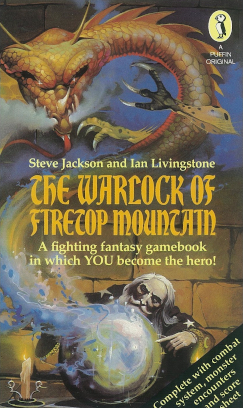
The Warlock of Firetop Mountain is a single-player adventure gamebook written by Steve Jackson and Ian Livingstone, and illustrated by Russ Nicholson. Originally published by Puffin Books in 1982, the title is the first gamebook in the Fighting Fantasy series. It was later republished by Wizard Books in 2002, and Scholastic Books in 2017. As well as launching the Fighting Fantasy series, the gamebook inspired two direct sequels and five novels, and has been adapted into a board game, an audio drama and a video game.
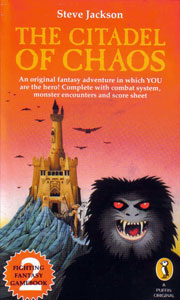
The Citadel of Chaos is a single-player adventure gamebook written by Steve Jackson and illustrated by Russ Nicholson. Originally published by Puffin Books in 1983, the title is the second gamebook in the Fighting Fantasy series. It was later republished by Wizard Books in 2002. The gamebook was also adapted into a video game.
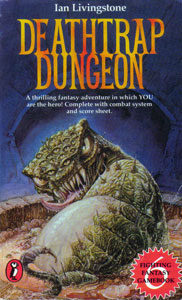
Deathtrap Dungeon is a single-player adventure gamebook written by Ian Livingstone, and illustrated by Iain McCaig. Originally published by Puffin Books in 1984, the title is the sixth gamebook in the Fighting Fantasy series. It was later republished by Wizard Books in 2002.

The Forest of Doom is a single-player adventure gamebook written by Ian Livingstone, and illustrated by Malcolm Barter. Originally published by Puffin Books in 1983, the title is the third gamebook in the Fighting Fantasy series, and the first of several to feature the character Yaztromo. It was later republished by Wizard Books in 2002. The gamebook was also adapted into a video game.

Match Day is a football computer game, published by Ocean Software in 1984 for the ZX Spectrum. It is the first game in the Match Day series, and was the creation of programmer Jon Ritman and Chris Clarke. Versions were later released for the Amstrad CPC and PCW, BBC Micro, Commodore 64 and MSX systems.
Crystal Computing, later renamed Design Design, was a British video game developer founded in 1982 by Chris Clarke and Ian Stamp while students at the University of Manchester. Graham Stafford, Neil Mottershead, Simon Brattel and Martin Horsley, joined the company as it expanded. The company's first software release was a compilation of games for the Sinclair ZX81, though it was with the ZX Spectrum that Crystal found its greatest success. A deal with the machine's manufacturer Sinclair to distribute Crystal's Zeus Assembler gave the company sufficient funds for a major marketing campaign for their next product, Halls of the Things, an arcade adventure game that became their most successful title.
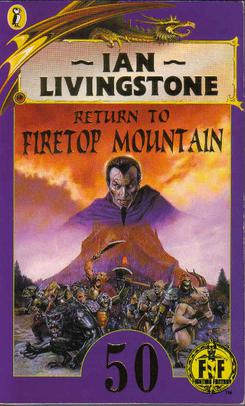
Return to Firetop Mountain is a single-player roleplaying gamebook written by Ian Livingstone and illustrated by Martin McKenna. It was originally published in 1992 by Puffin Books and was later republished by Wizard Books in 2003. The gamebook forms part of Steve Jackson and Ian Livingstone's Fighting Fantasy series, where it is the 50th volume in the original Puffin series (ISBN 0-14-036008-5) and the 16th in the later Wizard series (ISBN 1-84046-481-X).
Thorn EMI Computer Software was a British video games software house set up in the early 1980s as part of the now-defunct British conglomerate Thorn EMI. They released a number of games in the early 1980s, initially for the Atari 8-bit computers, and later for the ZX Spectrum, Commodore 64 and VIC-20 computers. In 1984, the Thorn EMI name was dropped in favour of Creative Sparks as the company were reportedly unhappy with their image in the video games market. A budget label, Sparklers, was created in early 1985 to publish titles at £2.50. Later in 1985, Creative Sparks, Sparklers and the distribution company, Creative Sparks Distribution (CSD) gained independence from Thorn EMI after a management buyout.

Bugaboo (The Flea), later published in Spain as La Pulga, is a video game written by the Spanish programming duo Paco Portalo and Paco Suarez for the ZX Spectrum and published by Quicksilva in 1983. It was later released for the Commodore 64 and MSX were produced. The Amstrad CPC port was published under the name Roland in the Caves using the Roland character.
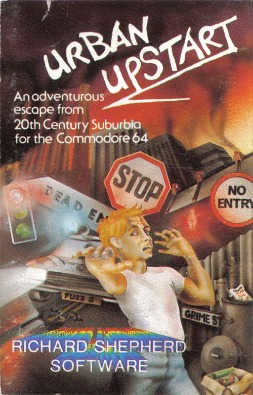
Urban Upstart is a 1983 text adventure programmed by Pete Cooke and published by Richard Shepherd Software for the ZX Spectrum and Commodore 64. Urban Upstart is set in the fictional British town of Scarthorpe, a particularly grim town with high crime and unemployment rates. The protagonist begins in their house at three o'clock in the morning, with the objective of escaping from Scarthorpe.
The Warlock of Firetop Mountain refers to a franchise created by Steve Jackson and Ian Livingstone:

Automonopoli, also known as Go to Jail, is an unauthorised computer version of the boardgame Monopoly, released in June 1983 by Automata UK for the ZX Spectrum. Although other two-player Monopoly computer programs already existed, the developer advertised that their Automonopoli was the first with an artificial intelligence strong enough to compete against and defeat human players.
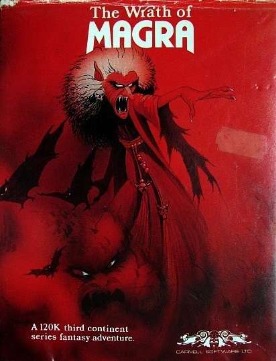
The Wrath of Magra is a role-playing video game published by Carnell Software for the ZX Spectrum in 1984. It is a sequel to 1983's Volcanic Dungeon.

Apocalypse: The Game of Nuclear Devastation is a video game based on the board game Apocalypse: The Game of Nuclear Devastation by Games Workshop.
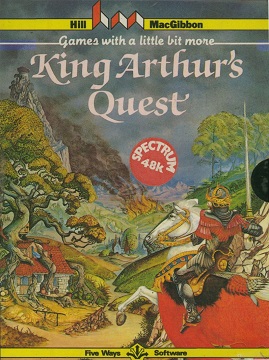
King Arthur's Quest is a first-person perspective graphic adventure interactive fiction video game developed by Five Ways Software and published by Hill MacGibbon for the ZX Spectrum in 1984. There was also a canceled Commodore 64 version.
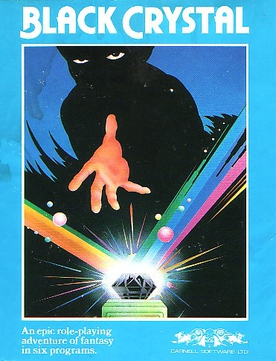
Black Crystal is an action-adventure game released in 1982 for the ZX81, ZX Spectrum, Commodore 64 and TI-99/4A computers by Carnell Software Ltd. It was the first in the "Third Continent Trilogy" of adventure games; followed by Volcanic Dungeon and The Wrath of Magra.
















